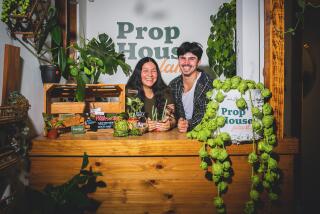Seeding Botanical Knowledge for Spring
- Share via
Here are two easy plant experiments that can be done inside. These prologues to spring are designed to hone gardening skills and provide some amusement.
* Experiment No. 1: This will allow close observation of seedling development. Roll up some blotting paper and slide it into a drinking glass so that it presses against the inside of the glass. Slide four dry beans, such as kidney or lima beans, between the paper and the glass a couple of inches from the bottom. Pour half an inch of water into the glass, replenishing it when necessary. Cover the glass with a plate until the beans sprout.
The beans will imbibe water and swell. In a little while a small root will poke out the end of each seed, followed by branch roots. Seedling roots are the first parts to develop so that they can search for a reliable water supply. Once awakened, a seed will die if dried again.
After the roots have made some growth, a small hooked shoot within the seed will expand and straighten, catapulting the whole seed up. Tiny leaves will unfold. In some seeds the new leaves push through the soil alone.
This experiment is a good reminder to keep garden seedlings moist. Also, make sure the soil surface is soft enough so seedlings can break through. A thin surface layer of peat, sand or compost, or a periodic light sprinkling of water, does this job.
* Experiment No. 2: Plants become pale and stretched out when hungry for light. Use the same setup as in the first experiment. Use two jars this time, one you place in a bright window, the other in a closet. After a week or two, the plants will look as if they came from different types of seeds.
Stretching out has a survival value for plants. Imagine a germinating seed buried in dark soil, pushing its way upward. Underground, which seedling has more chance of reaching the surface? Would it be a thick, stocky seedling with large leaves, or one with small leaves and a slinky stem, stretching for the light? It would be the slinky ones.
Once exposed to light, these pale, slinky plants become green and develop large leaves and thick stems.
This experiment is a good reminder not to plant seeds deeper than suggested on seed packets. Otherwise, seedlings might expire before ever reaching light.
Also, if you notice that a plant appears to be stretching in the direction of light and its leaves are small and pale, move it to a sunnier window or beneath fluorescent lights.






